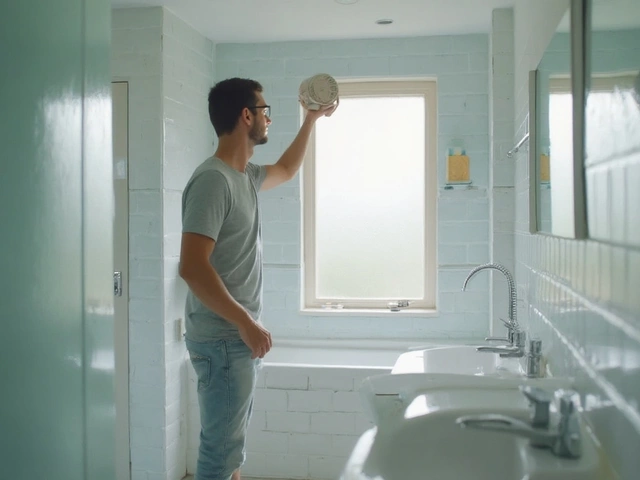Nothing kills the vibe in a kitchen or bathroom faster than damp walls, musty air, or stubborn smells that just won’t leave. If your extractor fan isn’t pulling its weight, these little headaches never seem to go away. The good news? You don’t need a toolbox stuffed with gadgets to figure out if your fan is working the way it should.
Start by flipping the switch and really listening. Does the fan kick on with its usual whir, or is it silent—or worse, making a weird rattling noise? Any change in sound can be a dead giveaway that something’s off. Also, put your hand near the vent. Can you feel a steady breeze, or is the air barely moving? If your hand can’t feel much airflow, neither can the stale air in your room.
- Spotting the Warning Signs
- Is It Getting Power?
- Simple Airflow Tests You Can Try
- Noise and Vibration—What’s Normal?
- Looking for Blockages or Dirt
- When to Call in the Pros
Spotting the Warning Signs
There’s no need to guess if your extractor fan is slacking off. The signs are right in front of you—you just have to notice them. The right clues can save you expensive repairs down the line. So, what should you look for?
- Damp or Foggy Mirrors: If you’re wiping down steamy mirrors long after a shower, your fan might be useless or not powerful enough. A working fan should clear mirrors in less than 10 minutes.
- Lingering Smells: Cooking odors or that musty bathroom scent hanging around? Extractor fans are made to clear the air—if the smell’s not gone within 20 minutes, something’s wrong.
- Visible Mold or Damp Patches: Mold near vents or on ceilings often means moist air isn’t going anywhere, which can lead to expensive decorating repairs if ignored.
- Unusual Sounds: A gentle hum is fine, but grinding, rattling, or loud buzzing is trouble. These noises usually point to loose parts, something stuck in the blades, or worn bearings.
- Weak or No Airflow: Put your hand right by the vent. If you don’t feel air being pulled in or pushed out, airflow’s not right—and neither is your fan.
The numbers don’t lie. The table below shows the average time a properly working fan should clear typical room humidity and odors:
| Room Type | Size (Sq. m) | Time to Clear Steam/Smells |
|---|---|---|
| Small Bathroom | 5 | 5-10 minutes |
| Medium Kitchen | 12 | 10-20 minutes |
Keep an eye out for these red flags. Spotting them early doesn’t just make life easier—it stops bigger repair headaches (and costs) from sneaking up on you.
Is It Getting Power?
If your extractor fan isn’t working at all, the first thing to check is if it’s getting any power. You’d be surprised how often it’s just a simple power issue—an average of 25% of extractor fan faults, according to UK Electrical Safety First, come down to no power at the switch or wiring problems.
First step: try the fan’s switch a few times. If nothing happens, check if the light in the same room works. If both are dead, you might have a tripped breaker or blown fuse. Here’s a fast way to figure it out:
- Look at your circuit breaker or fuse box. See if any switches are flipped or fuses blown. Reset anything that’s off.
- Test another device—like a phone charger—in the socket closest to your fan. If your charger works, the socket has power.
- If your fan is on a pull-cord setup, double-check it hasn’t snapped or gotten stuck. A worn-out pull cord is a common reason for silent fans.
For a wall-switch operated fan, pop the cover off (but only if you feel safe and the power’s off). Look for any obvious loose wires. Wired connections should be tucked away neatly, not dangling or burned.
If everything seems right but your fan is still dead, a simple plug-in tester or voltage detector pen (found at any hardware store) can tell you if the fan’s getting juice. Just be careful—never poke around with the power on unless you know what you’re doing.
| Common Power Issues | Quick Fix |
|---|---|
| Tripped breaker | Reset breaker switch |
| Blown fuse | Replace fuse |
| Loose wire connection | Secure or reattach wire (when safely possible) |
| Faulty switch or pull cord | Replace switch or cord |
Here’s a quick tip: Some extractor fans have a tiny LED or indicator light near the switch or housing. If it’s dark, that’s usually a sign it’s not getting power. No fancy tools needed to figure that one out.
Troubleshooting extractor fan power is a fast and easy first step. If you’re still stuck, then it’s time to check if anything’s blocking it or if there’s a bigger problem with the fan itself. Don’t skip the basics—they solve way more fan mysteries than you’d think.
Simple Airflow Tests You Can Try
Wondering if your extractor fan is actually doing its job? You don’t have to take the whole thing apart. There are a few quick and easy tests you can do without fancy tools. These practical tricks give you answers in just a few minutes—even if you're not handy.
- Toilet paper test: Turn on the fan and grab a sheet of toilet paper. Hold it right up to the grill. If the fan is in good shape, the paper should stick against the vent easily. If it falls down or just moves a little, your fan’s airflow might be weak.
- Smoke or incense test: Another option: light a stick of incense or a match and hold it near the extractor fan. Watch which way the smoke goes. If the fan is pulling, the smoke should get sucked in noticeably. If it drifts away or just hangs around, you’ve got a problem.
- Hand test: This one’s simple—just put your hand up near the fan with it on. You should feel air moving. No breeze? Time to do some digging.
Here’s a quick breakdown of what you might see and what it usually means:
| Test | Good Fan | Possible Issue |
|---|---|---|
| Toilet Paper | Paper clings tightly | Paper falls or barely moves |
| Smoke/Incense | Smoke gets sucked in | Smoke stays or drifts away |
| Hand | Strong airflow felt | Weak or no airflow |
Remember, a clean and well-maintained extractor fan should pass these tests easily. If yours flunks, it could be clogged, broken, or just plain tired from years of work. These tests take the guesswork out so you know where you stand—and you can tackle repairs or call for help with confidence.

Noise and Vibration—What’s Normal?
When you power on your extractor fan, a low, steady hum is pretty standard. That noise is just the motor doing its thing—no need to panic. The real problems creep in if you notice grinding, banging, or a clattering sound. Those aren’t normal and usually mean something is loose, broken, or desperately needs a clean.
Vibration is another big clue. Any fan will vibrate a little as it runs, but if you see it shaking the wall or rattling with every spin, that’s a red flag. Excessive movement might mean the fan isn’t mounted properly, the blades are unbalanced, or debris is stuck inside. You probably shouldn’t ignore this: too much vibration can rattle wires loose or damage the fan over time.
Here’s a quick table showing what’s normal and what’s not:
| Noise/Vibration Type | Normal? | Possible Cause if Not Normal |
|---|---|---|
| Soft consistent hum | Yes | --- |
| Rattling/clattering | No | Loose parts, broken fan blade, foreign object |
| Grating/squealing | No | Worn motor, lack of lubrication |
| Visible vibration of fan | No | Loose mounting, unbalanced blade, blocked airflow |
| Soft whoosh/air noise | Yes | --- |
Here’s a quick tip: if your extractor fan used to run quietly but you’re suddenly hearing more noise, don’t ignore it. Catching these problems early can save you from bigger, pricier repairs. Sometimes, you just need to tighten a couple of screws or clean out dust and hair that’s gotten stuck inside. If simple fixes don’t quiet things down, it’s probably time to check for broken parts or call someone who knows their way around fan repairs.
Looking for Blockages or Dirt
You’d be surprised how often the extractor fan gets jammed up by dust, grease, or even a family of spiders. Most fans start slacking off because their parts get clogged. Less airflow means more humidity, stink, and even mold creeping in. In the kitchen, all that cooking vapor and grease can gum up moving parts fast. In bathrooms, lint and dust sneak in through the vent. According to a 2024 Australian home survey, almost 60% of extractor fans tested had noticeable grime buildup affecting their efficiency.
Start by turning the fan off at the wall or isolator switch. Better to be safe while poking around electrical stuff. Take off the front cover—usually a couple of screws or some gentle pulling will do. Right behind it, you’ll often see a mess of dust, fluff, and maybe some sticky stuff if it’s near the kitchen.
- Use a vacuum nozzle first. Suck up as much loose lint, dust, and cobwebs as you can.
- Wipe down the blades and cover with a damp (not dripping) cloth. For sticky kitchen fans, a bit of mild detergent helps cut through the grease.
- Check the vent or ductwork too. Blockages here are a common reason for poor airflow. Shine a flashlight to spot any gunk or built-up mess.
- If you spot any dead bugs or larger obstacles, pull them out gently. No need to be rough—fan blades can break or bend.
Remember to dry all cleaned parts before snapping the cover back. If you notice dampness in the motor or wiring while cleaning, it’s a sign you might need a pro.
| Common Causes for Blockages | Frequency (%) |
|---|---|
| Dust & Lint Build-up | 42 |
| Grease Deposits | 29 |
| Spider Webs & Insects | 16 |
| Foreign Objects (toys, etc.) | 7 |
| Bird Nests at Exterior Vent | 6 |
Once you get into the habit, checking for blockages is no big deal. Do it every few months and your fan will work better, last longer, and you’ll notice less mess settling on your walls. A clear fan runs quieter, too, which never hurts.
When to Call in the Pros
So, you’ve done the basic checks. The fan's getting power, there’s no obvious blockage, but things are still off. This is when it makes sense to get a professional in. Here’s the deal: experts have tools to test airflow, diagnose wiring problems, and spot worn-out parts that you might miss.
Don’t mess with the wiring if you’re not 100% sure what you’re doing. According to UK government data, about 18% of all home electrical fires start with a faulty ventilator or bathroom fan. If there’s a burning smell, visible scorch marks, or blown fuses, that’s a sign to back away and call an electrician.
- The extractor fan won’t start at all, even after checking the mains and fuse.
- The fan is making loud grinding or screeching noises and there’s no dirt or blockage.
- You see sparks, smoke, or anything that screams “fire hazard.”
- There’s water leaking from the fan, which can mean serious electrical or structural issues.
- The airflow is weak, but ductwork and fan blades are already clean.
Think about the fan’s age, too. Most home extractor fans have a life expectancy of 7-10 years. If yours is older and constantly acting up, paying for endless repairs doesn’t make sense.
| Problem | DIY Friendly? | Call a Pro? |
|---|---|---|
| Loose cover or mild dust buildup | Yes | No |
| Electrical faults (wiring/fuse) | No | Yes |
| Persistent rattling, not fixed by cleaning | No | Yes |
| No power to the fan despite working switch | No | Yes |
| Wet patches or water leaks from fan | No | Yes |
Bottom line: If the basics don’t fix it, or you notice anything unsafe, don’t play the hero. Pros get the job done quickly and safely. Sometimes, that call is the smartest repair you’ll make all year.




